The dry rot (Serpula lacrymans [Wulf. ex Fr.]) - its way of life



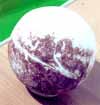

I. The origin of wood-damages and to the dry rot
Infestation by wood-destroying fungi and insects requires increased moisture, carbon compounds as energy suppliers and other nutrients such as proteins and fats. The proportion of nutritive substances in fresh wood is about 5 %.
If the timber construction is built according to the designs of constructive timber protection and the wood moisture does not increase during use, Serpula lacrymans cannot develop. If an infestation occurs, there is usually damage caused by moisture penetration. In the past, the causes were rather due to leaking roofs, broken roof drainage and burst water pipes in winter. Today, damage is also caused by water pipes in the wooden beam ceiling (bathrooms, hot water pipes, etc.) that are not watertight, as well as the formation of condensation on barrier layers and poor execution of the interior insulation, e.g. when the attic is extended.
Many of the minor damages to the wooden construction are not known to the house owner. But visible wood damage is also often misjudged and causes subsequent high renovation costs or problems with the sale.
Basically, dry rot is a wood-destroying fungus and not a catastrophe. The other wood-destroying fungi can also cause a great deal of damage and cause load-bearing wooden structures to collapse. The special thing about Serpula lacrimans is that it grows in hidden spaces, i.e. in cavities, and is therefore not immediately recognized.
This wood damage, the complete destruction of the ceiling beams under the bathroom, was not caused by the dry rot but by a wet rot fungus.
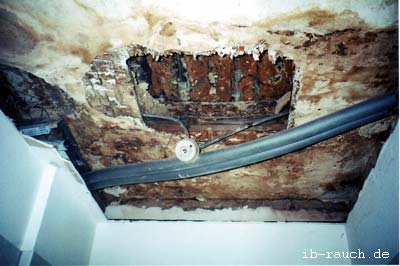
The real dry rot belongs to the department real fungi (Eumycota), class stand fungi (Basidiomycetes), order Aphyllophorales, family wart-sponges (Coniopharaceae), types Coniophora and Serpula. In the Brockhaus an assignment to the hole fungi is made. In the Brockhaus Biology Department the fungus is assigned to the porlins with the name Merulius lacrimans (= Merulius domesticus). To the family Porlinge, Poriaceae, belongs e.g. the white pore-sponge, Poria vaporaria, because of the similar damage-picture, brown cube-break (Destruktionsfäule) is confused. The real dry rot is also known under the name Merulius lacrimans. The genus Merulius was set up by frieze after purely external characteristics, what was certainly not otherwise possible at this time. To this family Fältlinge, Meruliaceae, the hellsporigen types are considered. From Persoon the brown-spurred representatives were classified into the genus Serpula.
II. The typical damage-picture of the dry rot
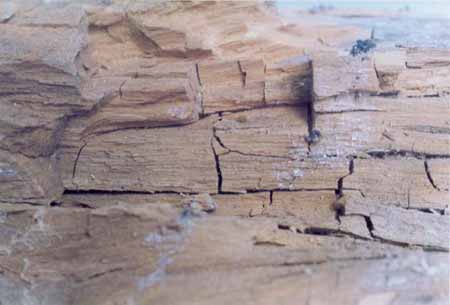
The real dry rot is a purely saprophilous fungus, that is, it attacks dead and blocked wood. Characteristic for this fungus is the brown rot (destructive rot). This fungus has specialized in the decomposition of cellulose. What remains is the lignin. This has a brown appearance. The damaged wood has cubic cubes on the surface with mostly 2 cm edge length. The cube brittleness is dark to bright brown. No growth occurs if the beams are effectively ventilated with air. If wood preservative is applied, growth occurs in the unprotected wood interior. If the wood is built in a boardlike manner, it will curve outwards with a rounded back. With e.g. infested door frames or plinth claddings made of wood, there is a slight warping, which is often only recognizable by the flaking of the paint. With optimal and long lasting infestation, the wooden construction is completely destroyed. Due to the concealed spread of damage, the damage is only visible relatively late. Further typically for the wood-destructive fungus is the fruit-body and the developed dirty-gray Myzel.
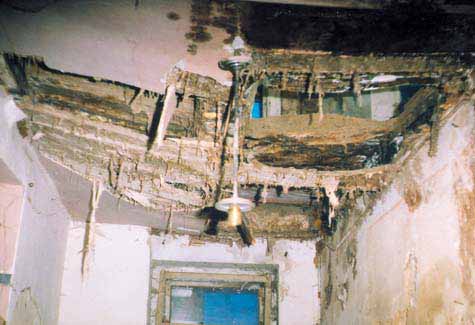
III. Growth factor for fungi destroying wood by moisture
The wood occurring in buildings is divided into three groups according to its humidity requirement.
- Group represented only by dry rot (15-30 %)
- Group of wet mushrooms (30-80 %)
- Low fungi ( from 80 %)
The real dry rot only needs a higher wood humidity of approx. 30% to 40% at the beginning of its growth. As minimum 17 to 20% and as maximum 90% are indicated. (Mombächer et. 1988) For comparison the cellar sponge (Coniophora puteana) prefers a wood humidity of 45 to approx. 70% and the white pore sponge (Poria vaporaria) 30 to 50%. A high wood humidity is required, for example, by the Donkioporia expansa (white rot fungus), whose damage can be considerable. This fungus often occurs at the same time as dry rot, as for example in the following picture.

Depending on the degree of moisture, certain wood-destroying fungi grow. At the respective degree of humidity other fungi cannot grow or only very slowly. In the case of water pipe damage, there is a high level of moisture locally, where the growth of wet rot fungi is more likely, such as Tapinella panuoides or one of the other wet rot fungi mentioned above. In this case a fast and rapid drying of all wood and other components is necessary. E.g. the wood, the cinder fill and the adjoining brickwork must be dried in the wooden beam ceiling. With it, the mycelium of the real dry rot cannot develop or only insufficiently, since the optimal moisture for its growth is available only shortly. If young mycelium of Serpula lacrymans becomes dry, it dies after a certain time. The phase of the dry-stiffness depends on the sizes of the other environment-influences and certainly also from the trunk itself.
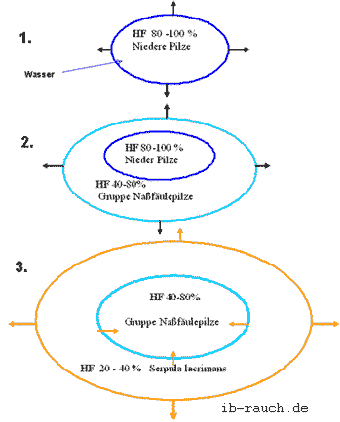
The relationships of a possible biological damage in a building with wooden constructions are shown in the left schematic. Water damage occurs that has not been detected and dried over a long period of time. A complete local soaking of load-bearing timber constructions initially leads to an infestation by lower fungi or bacteria, which grow at a timber moisture content of about 80 to 100 % and cause relatively little damage to the timber construction in relation to the basidia. If this moisture damage can spread, the edge areas have a lower moisture content and over a longer period of time offer favourable conditions for infestation by wood-destroying basidia (pillar fungi). Further spread or drying to a wood moisture content of about 40% creates favorable living conditions for Serpula lacrimans. This fungus displaces the wet rot fungi and thus grows on the moist but also on the dry wood construction.
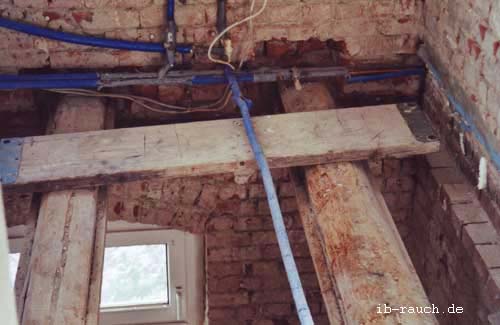
Due to the delayed damage detection as shown in the following picture, extensive damage can occur. Here the water pipe in the wooden beam ceiling was not properly soldered. Only after about 10 years the damage was detected over several rooms.
Damp rooms with water vapor-saturated air are particularly conducive to fungal growth. If the relative humidity falls below 95%, the destructive activity of house rot fungi diminishes considerably. The air humidity is related to the substrate moisture.
All fungi produce water during their metabolic process. When the cellulose is broken down, water and carbon dioxide are released. So they create a part of the necessary humidity for themselves "breathing water". This type of rot is called dry rot. If the rooms and the construction are well ventilated, this water can be removed. The real dry rot has become especially specialized and can grow so also under the fiber-saturation (with approximately 30% wood-humidity).
The practice has shown, from a certain size, the mycelium can spread also on dry wood with a wood-dampness of 12 %. Here the necessary water is transported over the strand mycelium.
Examples for endangered areas, where the air humidity can be very high due to insufficient ventilation:
- ood cupboards,
- unused AWC,
- Basement rooms,
- Corners of rooms behind cupboards and cold outside wall,
- Faulty floors in wooden beam ceilings on external walls, which are always exposed to rain,
- where the floorboards and skirting boards are closed etc.
IV. Growth factor temperature for wood-destroying fungi
The temperature as growth factors for the dry rot
V. The influence of light and air exchange on the growth of wood destroying fungi
Fungi are chlorophyll-free and do not require light for their growth, although this has an inhibiting effect in some cases. A certain amount of light is required for the formation of fruiting bodies. (G. Langendorf)
| Mushroom species | Growth after days in mm | |
|---|---|---|
| Sunlight | diffused lighting | |
| Serpula lacrimans | 0 | 25 |
| Coniophora puteana | 25 | 80 |
| Antrodia vaillantii | 11 | 25 |
This makes it clear why a fungal infestation remains undiscovered for a relatively long time. They prefer darker and concealed rooms. Since the real dry rot gets along with relatively low humidity opposite the other fungus-types, its infestation is recognizable only with the statement of a bigger damage usually. If there is a sufficient continuous supply of moisture, such as a defective heating or water pipe, Coniophora puteana causes much greater damage in the same period.
Mushrooms exposed to light are inevitably subject to an exchange of air, which in turn means an exchange of moisture. Mushrooms produce, as already mentioned in the point moisture, a part of the required water themselves. This water is thus removed and thus reduces the metabolic process. The importance of the draft and the drying out connected with it are emphasized by different authors, like Grosser, Jennings and Bravery, Schmidt among others.
VI. Function and characteristics of the mycelium of Serpula lacrymans
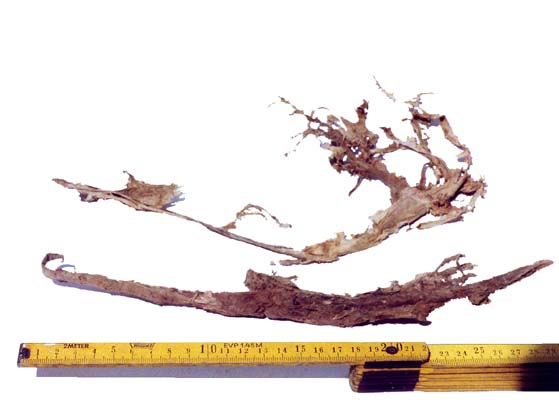
The surface mycelium is thick, cushion-shaped and at first snow-white, later grey, sometimes slightly yellowish or even wine-red spotted. Older hyphae form oxalic acid crystals. The mycelium can also be recognized by the fact that it tears in fiber or growth direction. It can be detached from the base well. The mycelium-types are distinguished into air-mycelium, surface-mycelium, strands and Zwischenmyzel. Very young mycelium can hardly be distinguished macroscopically from Coniophora puteana, which is white until yellowish and shows no wine-reddish stains. The strands of the EH are dirty-gray and up to over 10 mm thick. Their shape is roundish, ribbon-like, lobed or takes on the shape of the cavity, which is grown through. (In the joint of a doorframe the strand had taken on a square shape 1 cm thick. Behind baseboards they are somewhat flattened). When dry, the strands break like wood of the same thickness. Also thin mycelium breaks.
Especially in the cellar masonry roots of nearby trees or bushes can be found. The roots usually differ in their dark brown appearance and are very flexible. They also grow out of the wall and do not have a lighter mycelium. They can be easily distinguished visually from a fungal infestation.
The mushroom with its strong strands, sometimes up to 3 cm thick rhizomorphs, can penetrate through masonry and even through the ground or under the pavement to the neighbouring building. These long mycelium strands form an efficient water pipe system. It enables the fungus to attack even dry building parts and dry wood. [O. Schwantes 95/S.261-262)
In the town of Markkleeberg, for example, the water from the water pipe in the basement was led over a distance of about 10 m to the mycelia and fruiting bodies which were several square metres in size. On the surface of the water pipe there was mainly condensate. The mass transport in the strands is coupled with the water transport and takes place via osmotic pressure equalization. Investigations with different radioactive substances support this theory. (Weigl and Ziegler 1960, Jennings and Bravery 1991) The function of water release at fruiting bodies and hypen tips is not completely clarified.
In the following picture, one sees well the mycelium of the Serpula lacrymans at the old blanket-beams and at the laterally attached lateral flaps. The reorganization failed completely.

The mycelium is also able to penetrate components such as concrete. Only by H-J. Rafalski the growth direction diagnostics was worked out as an important characteristic of the causes and damage removal. The fruit-body usually is in elliptical and round form usually approximately 10 cm, however also until 2 m2. The edge of the plate is usually thickened like a bulge, whereby the centimetre-wide white growth edge is particularly noticeable. The fruit layer is rust brown discoloured and wrinkled. The fruiting body prefers diffuse light and can thus be found on the underside of wooden floors, on the cellar ceiling or behind lined surfaces such as cupboards, couch, wall panelling. Growing fruiting bodies smell pleasantly fungus-like, decomposing like petroleum. (A fungal smell is also present when large quantities of mycelium are present). The fruiting body forms rust-coloured spores and deposits in corners like dust. Older fruit-bodies become dark until almost (black). If the fungus does not have enough "growth strength", the brown spores form in a thin layer on the cotton wool-like mycelium. The brick to brown-red spores are ellipsoid and bean-shaped flattened on one side and have a size of 8 ... 12 micrometers by 4.5. 8 microns.
The fruit-body of Serpula himantioides (wild dry rot) is somewhat smaller but on the basis of morphological characteristics only heavily from the real dry rot to distinguish. The types can be distinguished well with genetic methods (Moreth-Kebernik u. Schmidt 2000). Predominantly, this type occurs outside and with high humidity also at the framework and never (?) at the stonework.
VII. The cytological processes
It can be assumed that various processes (exocytosis of enzymes for cell wall construction, release of cell wall building blocks and nutrient uptake) take place at the hyphal tips. The catalytic activity of an enzyme depends mainly on the substrate concentration, temperature and pH value. If individual or all conditions change, the activity is reduced or even temporarily suspended. For example, a single enzyme molecule can break down up to 5 million substrate molecules into their constituent parts within one minute. (Hubacek, 88 p. 29) At the tip of the hypha, the cell wall is permeable as well as plastic and thus easily allows an exchange with the environment. Up to now, the temporal or spatial relationships between the release of enzymes and cell wall polysaccharides as well as the metabolic processes of the sessile fungi are only little known. Basic research has hardly been done, only descriptions of the phenomenon exist. (Schmidt 1994)
VIII. The substrate and environmental influences
The role of humidity and temperature in relation to growth conditions has been discussed in the above sections. In addition, other influencing factors also have an effect in practice.
As already mentioned, the pH value plays an important role in enzyme activity. Building materials such as brick or sand are preferred by the fungi. They have a pH-value of 5-6, whereas alkaline building materials such as lime, limestone, cement, concrete and wood-wool building boards have a rather inhibitory effect. (Weißenfels) In an approximately 60-70 year old villa, the hollow floorboards made of concrete were completely marbled. The alkaline effect as a growth retardant is here strongly reduced by the carbonation. In the normal state of the concrete due to its Ca(OH)2 solution, the pH value is 12.6. In porous concrete, where Ca(OH)2 is carbonated by C02, the pH value is 8-10 . The pH value of concrete and cement plasters is also reduced because they emit CO2 over a longer period of time.
In the WTA-leaflet it is pointed out that alkaline materials as mentioned above are needed by the dry rot to neutralize the oxalic acid it produces. (WTA-leaflet p. 4). This should be from the oxalacetate a product or intermediate product in the citrate cycle of the splitting of the carbon molecule chains. The white pore sponge (antrodia vaillantii), for example, neutralises chemically protected wood in which copper compounds are present. The increased production of oxial acid results in copper oxalate, which precipitates. Other components such as chromium and arsenic compounds lose their fixation and become water-soluble. (Holzschutz-Tagung 2000) Several older, relatively smaller active infested areas (approx. 1 - 2 m2) were plastered with new lime plaster by the tenant himself some years ago. This resulted in a standstill of growth. The old mortar in the wall joints still showed the mycelium and the new plaster did not show any mycelium.
The same can be observed if the masonry is made of different building materials, e.g. bricks and sand-lime bricks. Here there is a very small boundary area in the course to the other building material. In practice, this can be a wall made of bricks that was built subsequently. Sand-lime bricks are covered by mycelium just as with brick. However, the brick is more porous and the mycelium grows into these joints. With low infestation of the stonework from stones from clay, the mycelium grows predominantly into the joints. If a strong affection is present, so one finds the mycelium also in the loam-stone. At rammed-clay-walls, the straw is decomposed above all. The mycelium grows so through the entire moist wall-cross section. So, the affection-area can spread also into completely dry wall-sections of the rammed-clay-wall.
A minor water damage several years ago slowly but continuously caused damage by Serpula lacrymans. The few fresh mycelium under the wood planking grew at a wood humidity of less than 12%. Earlier the source of moisture was an old water pipe. This water pipe was turned off however for many years. Analogous example is a stair landing, where the quite powerful mycelium grew from the middle of the landing towards the outer walls and up to the outside toilet. The cause of this damage was obviously the wiping water from the regular stair cleaning. However, no stair-cleaning took place for a long time any more and therefore no water was also available. This was noticed during the repair of the plaster on the ceiling in the staircase. The wood humidity of the flooring of the stair landing was in the range of 12 %.
In the majority of similar older loss areas, growth stopped of its own accord at some point. Laboratory tests on the degradation performance of different logs showed dryness losses of between 4 and 35% after 16 weeks incubation, at 20-21°C and 20-40% wood moisture. The different logs showed a very uneven degradation pattern (Abou Heilah 1977). By Walchli 1973, dry wood weight losses after 18 weeks and 21°C are reported to be 60% for larch and pine heartwood and 31.5% for pine heartwood and 1.8% for oak heartwood. The increased intrinsic resistance to pine heartwood was found in a severely damaged object. The sapwood portion of the 170 year old pine ceiling beams was completely destroyed and the heartwood portion almost undamaged. When the ceiling beams were cut, the wood smelled of resin. Not only in the laboratory, but also in practical cases of damage, different trunks under different growth conditions are likely to cause different types of damage. An exact source and reason why 1.00 m beyond the visible damage area the wooden beam has to be cut off and 1.50 m the plaster has to be removed as a safety zone cannot be given.
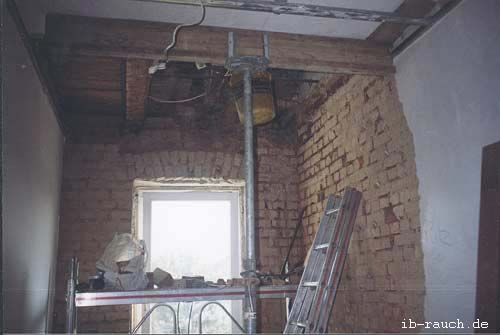
Earlier investigations in Eberswalde showed that growth up to 40 cm above the visible area of a wooden beam is possible. Thus the lower limit of the exception in the DIN 68800 and in the Beuth comment to the DIN with 50 cm can be regarded as a plausible size.
If Serpula lacrymans is used to repair damage, it should be noted that several and quite different factors may play a role in the final occurrence of the damage.
IX. Health risks through the dry rot
Due to its concealed expansion, especially in the wooden beam ceilings or in the cavities in the converted attic floors, one often notices the major damage to the statically supporting wooden parts very late. Due to the reduced load-bearing capacity, a danger of collapse should always be expected until the extent of the damage has been determined by a thorough examination.
During intensive infestation, gaseous metabolic products of the fungus are said to cause headaches and nausea. The spore dust can cause severe spore allergies. O. Schwantes 95/S. 227 u. 262] However, high concentrations must be present in the building for this. Other health impairments of Serpula lacrymans are not known.
X. Further dry rot species
Serpula lacrimans (var. himantioides) dry rot ( = Merulius silverster)
It possesses less destructive power than the real dry rot and is relatively rare. The optimum temperature for it is 24 to 27 °C. It grows mainly outdoors on softwood stumps and on softwood in buildings. In buildings it occurs less frequently. The fruiting bodies are thinner, without bulging edges and never form consoles. The mycelium becomes only so thickly wei a string.
Serpula minor
It occurs predominantly in buildings, but does not have the destructive power of Serpula lacrimans. Has smaller spores and white mycelium strands.
Leucogyrophana pulverulentaThe little dry rot
Possibly this could be the Serpula minor, since the descriptions match. In the literature no definite statement could be found yet).
The fruiting bodies are more delicate and reach a diameter of max. 15 cm. The thickness becomes about 1 to 2 cm, are very flat and have a white edge. Optimum growth temperature 18 to 22 °C. The fungus attacks mainly coniferous wood.
Serpula pinastrie, Leucogyvophana pinastri Sclerotia sponge or Gelbrandiger sponge
It is also a brown fungus on used wood (mainly coniferous wood), but it is very rare in our country. It requires initial moisture of the wood, but can cause considerable damage when it appears. The fruit bodies can reach a diameter of 15 to 20 cm. The thickness hardly reaches 5 mm. The mycelium is chrome-colored to yellowish-gray and much thinner. In the yellowish-brown strand-mycelium, the fiber-hyphas are missing.
Serpula eurocephala
grows on living and dead bamboo and can cause quite a lot of damage in the tropics to bamboo that has been used. These species grow in the tropics of South America, Africa, Asia and Australia.
In several federal states, as also in Saxony, the infestation through the dry rot is subject to the obligation to report the building supervision authority according to the building code (e.g. SächsBO § 16 Abs. 2). Combating and repairing the damage must be carried out by a specialist company on the basis of an assessment by an expert.
First of all, the causes and possible sources of moisture must be eliminated.
If an immediate complete sanitation cannot take place, the growth of the fungus should be prevented as far as possible. An important basis is the exposure of the damage-area, so that the wood-beams or other load-bearing wood-parts can dry well through air-circulation. Direct sunlight also reduces the growth rate. Likewise the damage propagation becomes visible and appropriate reasonable safety measures, such as support, closing of the damaged area can be made. Without exposure and determination of the spread of the damage, the infestation remains an incalculable risk.
The control measures to be applied to dry rot can be found in leaflet 1-2-03/D of the Scientific-Technical Working Group for Monument Preservation and Building Renovation (WTA) and DIN 6800 Part 4.
It is not recommended that you carry out the renovation yourself without professional support.
XII. Literature compilation to the dry rot: (incomplete)
- Polanyi, Peter; Holzschutz ohne Menschenschaden: Farben, Lacke und Holzschutzmittel anwenden ohne sich und die Umwelt zu vergiften 19992 Quelle: Deut. Bücherei Leipzig 1992 A 26962
- Weissenfeld; Peter; Holzschutz ohne Gift?: Holzschutz und Oberflächenbehandlung, Quelle: Deut. Bücherei Leipzig 1990 A 28536
- Müller,Klaus; Holzschutz in Tabellenform, Wissenspeicher, Inst. für Weiterbildung Bauwesen Leipzig 1985, Quelle: Deut. Bücherei Leipzig 1985 A 24441
- Hausschwamm an Holzbauteilen IRB 1990; Quelle: Deut. Bücherei Leipzig SA31458-1716
- Hofmeister, Gertraud; Bauschäden an der Altbausubstanz in den neuen Bundesländern (Feuchtraum, Bad, Küche) Forschungsbericht 1995; Quelle: Deut. Bücherei Leipzig 1996 B 1555
- Hofmeister, Gertraud; Bauschäden an Holzbalkendecke in Feuchtraumbereichen ... Forschungsbericht 1995; Quelle: Deut. Bücher Leipzig 1995 B 24946
- Langendorf, Günter; Holzschutz, Handbuch für Fachleute; Quelle: Deut. Bücherei Leipzig 1988 A 22932/1
- Willi, Mönck; Schäden an Holzkonstruktionen, Verlag für Bauwesen Berlin 1995 und neuere Ausgaben
- Björn Weiß, André Wagenführer, Kordula Kruse; Beschreibung und Bestimmung von Bauholzpilzen, DRW-Verlag 2000
- Müller, Ingo; Alternative Verfahren der Hausschwammbekämpfung, Vortrag Holzbaufachtagung in Quedlinburg 19.03.1999
- Rafalski, Hans-Joachim; Vortrag in Quedlinburg, Spezielles zum Echten Hauschwamm insbesondere zur Wuchsrichtungsbestimmung.
- Hubacek; Spezialgebiete der Chemie, Oldenburg Wien 1986
- DIN 68800 Teil 4; Bekämpfungsmaßnahmen gegen holzzerstörende Pilze und Insekten
- Beuth-Kommentare zum Holzschutz, Erläuterung zu DIN 68800-2,-3,-4, DGfH (Deutsche Gesell. für Holzforschung e.V.)1998 [www.din.de/beuth]
- 22. Holzschutz-Tagung "Maßnahmen zum Schutz des Holzes" in Bad Kissingen vom 17. bis 18. Oktober 2000. Vorträge, S.93-99; Herausgeber Deutsche Gesellschaft für Holzforschung (DGfH), München 2000
- brockhaus - ABC Biologie -; VEB F.A. Brockhaus Verlag Leipzig 1970 S.337
- Schmiedeknecht, Martin u.a.; Urania Pflanzenreich, Niedere Pflanzen, Verlag für populärwissenschaftliche Literatur, Leipzig 1974
- www.stud.uni-hamburg.de/users/Serpula/Gesundheitsgefahr.htm
Different pictures to the real dry rot infestation. Further very nice pictures were provided by Mr. Dipl.-Ing. Gerd Gatkowsky (Halle). Picture 1 (81 KB) Picture 2 (95 KB) Picture 3 (63 KB)
© Altbausanierung | Bauideen | Blog | Sanierungskosten | Impressum | AGB/Datenschutzerklärung | 5/2013 ![]()
